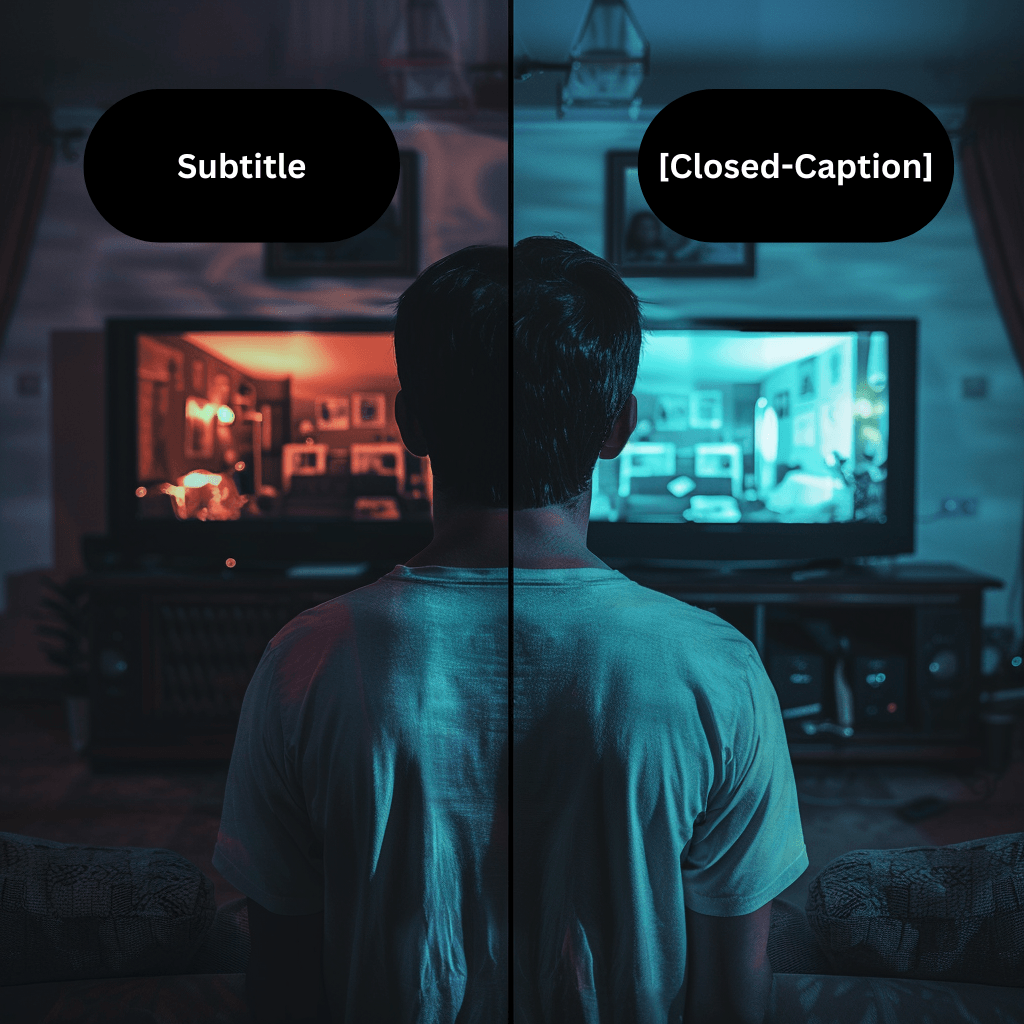Subtitles vs. Closed Captions: Enhancing Accessibility and Engagement on Video Platforms
Enhancing Media Accessibility with Subtitles and Closed Captions
In today’s digital age, accessibility in media is not just a courtesy—it’s a necessity. As video content becomes increasingly prevalent across various platforms, ensuring that it is accessible to all audiences, including those with hearing impairments or non-native language speakers, is crucial for creators and distributors. This inclusivity not only broadens the reach of content but also enhances user engagement and satisfaction.
Subtitles and closed captions are two fundamental tools that play a pivotal role in making videos more accessible. While they might seem similar at first glance, each serves unique purposes and meets different needs within the diverse spectrum of viewers. Subtitles primarily assist in understanding the dialogue by displaying text corresponding to the spoken part of a video in the same or a different language. On the other hand, closed captions go a step further by describing background noises, phones ringing, and other audio cues that are essential for those who are deaf or hard of hearing to fully experience the content.
Understanding the distinct functions and applications of subtitles and closed captions is essential for anyone involved in the production and distribution of video content. This knowledge ensures that all viewers have equitable access to media, regardless of their hearing ability or language proficiency. In the following sections, we will delve deeper into the differences between subtitles and closed captions, discuss when and how to use each, and explore their implementation across popular video platforms like YouTube and Vimeo.
Understanding the Basics
Before diving into when and how to use subtitles and closed captions, it’s crucial to understand what each term specifically refers to and the fundamental role they play in media accessibility.
Subtitles are text overlays that appear on the screen during a video to communicate spoken dialogue. They are primarily used for translating the spoken language into another language that the viewer understands, but not the original speech. This allows viewers who are not fluent in the language of the dialogue to follow along with the content without necessarily understanding the spoken aspect. Subtitles can also be used in the same language as the dialogue for viewers who prefer reading along or are in a noisy environment where hearing the audio might be difficult.
Closed Captions, on the other hand, offer a more comprehensive solution for accessibility. They include everything that subtitles do but go beyond to also incorporate descriptions of non-speech audio elements that are crucial for understanding the context and nuances of the video. These elements include background noises, the sound of music, and other auditory cues like laughter or a door slamming, which are denoted within square brackets or via other indicators. Closed captions are specifically designed to assist viewers who are deaf or hard of hearing, ensuring that they can receive a full multimedia experience similar to that of hearing audiences.
Both subtitles and closed captions are typically displayed at the bottom of the screen, and both can be toggled on or off by the viewer, depending on their needs or preferences. Understanding these tools is the first step towards creating accessible content that caters to a diverse audience, enhancing both the reach and the inclusivity of media content across various platforms.

Distinguishing Between Subtitles and Closed Captions
Understanding the nuanced differences between subtitles and closed captions can significantly enhance a content creator’s ability to cater to diverse audiences effectively. While both tools aim to make video content more accessible, their specific uses and features are tailored to different viewer needs.
Content Specifics:
- Subtitles are focused solely on translating or transcribing spoken dialogue. This allows viewers who do not understand the audio language—either due to a language barrier or a noisy environment—to follow the narrative. Subtitles typically do not include non-verbal audio cues, assuming that the audience can hear and interpret these sounds themselves.
- Closed Captions, on the contrary, provide a fuller audio-visual context that includes all spoken words and significant non-verbal sound effects and musical cues. These are indispensable for viewers who are deaf or hard of hearing, as they describe sounds like “[dog barking]” or “[thunder rumbling]”, which are crucial for capturing the full ambiance and intent of the scene.
Visual Presentation:
- Subtitles generally maintain a streamlined appearance. They are displayed as plain text, often white with a black outline, to ensure clear visibility against varying backgrounds. The simplicity of subtitles aids in their primary function of conveying spoken words without distracting from the visual experience.
- Closed Captions require a more detailed approach to help differentiate between dialogue and other sounds. They might use brackets or a different text color to indicate sound effects or music, and changes in speaker are often noted to aid comprehension. Such formatting is vital to provide clarity and context, ensuring that all viewers have a similar understanding and appreciation of the content.
Integration with Media:
- Subtitles can sometimes be limited in the number of available language options, focusing primarily on the most commonly spoken languages of the audience or platform. This is due to their main function of facilitating language comprehension.
- Closed Captions are more frequently provided in the original language of the video to accommodate those with hearing impairments. However, as global accessibility standards evolve, more content providers are expanding their closed caption offerings to include multiple languages, thus broadening accessibility.
By choosing the appropriate tool—subtitles for language translation and closed captions for a comprehensive auditory depiction—content creators can ensure their media is accessible to all, regardless of hearing abilities or language knowledge. This distinction not only enriches the viewer’s experience but also promotes inclusivity across digital media platforms.
When to Use Subtitles vs. Closed Captions
Choosing whether to use subtitles or closed captions in video content should be guided by the specific needs of the audience and the viewing context. Understanding when to employ each tool can help maximize accessibility and viewer engagement.
Scenarios for Using Subtitles:
- Foreign Language Films: Subtitles are ideal for translating foreign language films into the viewer’s language. They allow audiences to appreciate the original performance while understanding the dialogue in their own language, maintaining the film’s authentic voice and emotional impact.
- Silent Public Viewing Environments: In settings where audio is impractical or disruptive, such as in bars, airports, or gyms, subtitles provide a means for viewers to follow the content without sound. This scenario is common for news broadcasts or sports games where the dialogue or commentary is key to understanding the unfolding events.
Scenarios for Using Closed Captions:
- Ensuring ADA Compliance: In the United States, the Americans with Disabilities Act (ADA) mandates the use of closed captions to make video content accessible in many public venues and online platforms. This legal requirement ensures that individuals who are deaf or hard of hearing have equal access to audiovisual media.
- Enhancing Comprehension for Audiences with Hearing Impairments: Closed captions are essential for providing a complete viewing experience for those with hearing impairments. By including both spoken words and relevant non-dialogue audio cues, closed captions ensure that all viewers can fully understand and enjoy the content.
In both cases, the decision to use subtitles or closed captions is not just about legal compliance or expanding audience reach; it’s also about fostering inclusivity. By thoughtfully integrating these tools into video content, creators can cater to a broader spectrum of viewer needs and preferences, making media truly accessible to everyone. This approach not only enhances the individual’s viewing experience but also supports broader social inclusion efforts across the media landscape.

Implementation on Video Platforms
Effective use of subtitles and closed captions extends beyond understanding their differences and applications; it also involves knowing how to implement these tools on various video platforms. Platforms like YouTube, Vimeo, and others have specific features and guidelines that facilitate the addition of these accessibility options.
Handling Subtitles and Closed Captions Across Platforms:
- YouTube: YouTube offers a robust system for adding subtitles and closed captions, enabling creators to upload their own files or use automatic speech recognition technology. The platform also allows for community contributions to subtitles, enabling viewers to add translations and captions, which the creator can then review and approve.
- Vimeo: Vimeo provides similar functionalities, allowing video creators to upload subtitle and closed caption files in various formats. It supports user engagement by letting viewers choose subtitles or captions from the video player’s settings, enhancing accessibility across diverse audiences.
- Other Video Platforms: While features can vary, most modern video hosting services offer tools for adding and editing subtitles and closed captions. These tools typically support standard file formats like SRT or WebVTT, which are widely used for their compatibility and ease of use.
How Creators Can Add Subtitles and Closed Captions:
- Creating the File: Creators can generate subtitles and closed captions manually by creating SRT or WebVTT files, or they can use software tools that automatically transcribe spoken content.
- Uploading to the Platform: Once the file is ready, it can be uploaded directly to the video on the platform. Creators should sync the text with the audio to ensure accuracy and viewer comprehension.
- Editing and Updating: Most platforms allow for easy editing after upload, so creators can make adjustments based on viewer feedback or to correct errors.
Legal and Ethical Considerations:
- Legal Compliance: In many jurisdictions, providing closed captions is not just a courtesy but a legal requirement, especially for content broadcasted publicly or produced by large media companies. This compliance ensures that all individuals, regardless of hearing ability, have access to video content.
- Ethical Responsibilities: Beyond legal obligations, there is an ethical responsibility to provide accurate and clear subtitles and closed captions. This means avoiding automatic captions that may contain errors, ensuring that descriptions of non-verbal sounds are included, and regularly updating content to maintain accessibility standards.
By implementing subtitles and closed captions effectively, creators not only adhere to legal standards but also demonstrate a commitment to inclusivity, ensuring that their content is accessible and enjoyable for as wide an audience as possible. This thoughtful integration of accessibility features not only enhances viewer experience but also supports a more inclusive digital media environment.
Benefits of Using Subtitles and Closed Captions
The inclusion of subtitles and closed captions in video content extends far beyond compliance and accessibility; it significantly enhances the viewing experience for all audiences. These tools are instrumental in expanding viewership and improving the overall utility of media.
Expanding Audience Reach:
- Increased Accessibility: By incorporating subtitles or closed captions, content creators can reach a broader audience, including individuals who are deaf or hard of hearing, non-native speakers, and even those in sound-sensitive environments. This inclusivity not only opens up content to more viewers but also helps in building a more diverse viewer base.
- Global Engagement: Subtitles, in particular, play a crucial role in crossing linguistic barriers. They enable viewers from different linguistic backgrounds to enjoy content irrespective of the original language of the dialogue, thus promoting global distribution and appreciation of media.
Enhanced Viewing Experience for All Audiences:
- Improved Comprehension: Subtitles can help all viewers, not just those with hearing impairments or language differences, to better understand the dialogue and narrative nuances, especially in complex scenes with background noise or multiple speakers.
- Educational Benefits: For those learning a new language, subtitles in both the native and target language can serve as an effective learning tool, enhancing language skills and providing a practical context for language use.
- Increased Focus and Retention: Both subtitles and closed captions can aid in better focus and information retention for viewers, as reading along with auditory input has been shown to reinforce comprehension and recall.
Cultural Inclusivity:
- Promoting Cultural Exchange: Subtitles allow films and shows to be shared across different cultures, promoting a deeper understanding and appreciation of foreign storytelling and production styles.
- Accessibility as a Norm: Implementing subtitles and closed captions fosters an environment where accessibility is valued and normalized, encouraging more creators to consider diverse audience needs from the outset of production.
The strategic use of subtitles and closed captions not only ensures compliance with accessibility laws but also enhances the entertainment value of content for a wider audience. This broader appeal can translate into increased viewer satisfaction, higher engagement rates, and potentially greater monetization opportunities for creators. By prioritizing these tools, content creators not only meet a wide range of viewer needs but also contribute to a more inclusive media landscape.
Embracing Subtitles and Closed Captions for Enhanced Accessibility and Engagement
Understanding the distinct roles and applications of subtitles and closed captions is crucial for any content creator who aims to make their videos as accessible and engaging as possible. These tools not only serve different segments of the audience based on their hearing and language needs but also significantly broaden the reach and impact of media content.
By integrating both subtitles and closed captions into video productions, creators can ensure that their content is inclusive and accessible to a diverse audience, including those with hearing impairments and non-native speakers. This not only complies with accessibility standards but also enhances viewer engagement by making content more understandable and enjoyable for all viewers.
Content creators are encouraged to consider these accessibility features as essential components of their production process. By doing so, they contribute to a more inclusive media environment and take full advantage of the opportunity to connect with a global audience. In an increasingly digital world, such inclusivity is not just beneficial—it’s imperative for success and societal progress.

